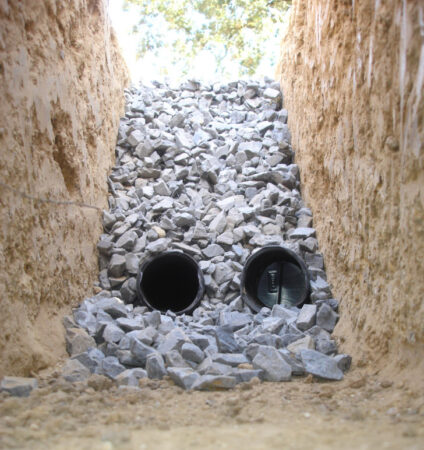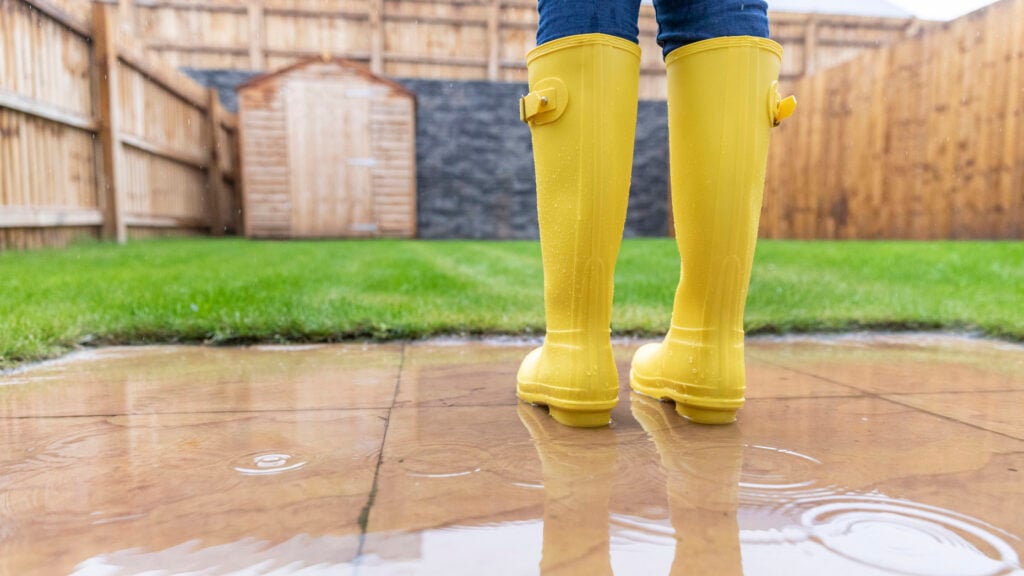When water pools in an area where it is unwanted, mechanical methods can be employed, but gravity may be the best solution over the long term. Enter the French drain.
Sometimes, the solution to a water drainage problem can be so simple and low tech that it seems hard to believe.
When water pools in an area where it is unwanted, mechanical methods can be employed, but gravity may be the best solution over the long term. Enter the French drain.
What is a French drain?
A French drain, named for farmer Henry Flagg French, born in 1813, is a method to redirect water from a structure or a saturated area outdoors. Simply defined, a French drain is a drain pipe enclosed in a gravel-filled trench. Henry Flagg French originally called this type of drain a “cellar drain,” but it was ultimately renamed a French drain, after its inventor.
As with all simple solutions, there are variables to the steps involved, and any deviation can negatively affect the results. A French drain is a simple and effective solution for poorly draining lawn areas or to redirect water away from a foundation or basement where it is pooling.
Credit: Wikimedia Commons
How does it work?
The most important component of the French drain is the slope of the drainpipe, so the runoff will follow the drain to the desired destination.
Surface water and groundwater must ultimately collect somewhere, and non-porous soil will only result in a pooling of water on the ground’s surface. To dry out a yard, or prevent water from entering a basement, redirecting it to a dryer and more porous area is the solution.

A French drain | Credit: Scooter133 / Wikimedia Commons
A trench, 8 inches wide and between 12 inches and 14 inches deep, is dug in the ground, leading away from a structure or wet area in the landscape.
The biggest omission that can occur prior to digging is the failure to research underground utilities or power lines. Trenching through a power line can be both dangerous and expensive to repair.
The crucial requirement is the slope of the trench — of at least 1 percent — so that gravity will propel the water away from the site where it is pooling. A one percent slope means that the trench should slope down at least 1 inch for every 10 feet of pipe.
The bottom of the sloping trench is lined with round rock, which is smooth, not jagged like gravel, at least 3 inches to 4 inches in depth. Some French drains lined with gravel are less effective, as the gravel is absorbed into the soil, requiring replacement over time.
Once the trench has been excavated, a perforated pipe is installed to carry the water away from the pooling site to a dryer area. The perforated pipe, which in the past was composed of terracotta, but is now more commonly comprised of polyvinyl chloride or PVC.
The PVC piping is available as rigid piping and corrugated, with corrugated being the better choice, as it is more flexible. The perforated piping is wrapped in a non-woven geotextile drainage fabric that controls the travel of soil and gravel into the pipe, preventing clogs.
Lining the trench with landscape fabric further assures that round rock and gravel will not be absorbed into the soil below the underlying gravel and pipe. Wrapping the perforated drainpipes in the drainage fabric further ensures that the water will travel freely without being affected by soil or gravel in the pipe.
A final error that can occur after the drainage fabric, rock, and pipe is installed, is to replace the originally excavated soil. If this soil did not drain properly before the drain was installed, it will not change substantially afterward. In this case, it’s better to place more round rock on top of the pipe and fold the extra drainage fabric over the pipe and rock. Fill in the trench with porous soil mixed with sand to assure drainage.
Another option is to have the French drain terminate in a dry well, catch basin or channel drain, all of which are types of underground containers filled with stone and gravel. The dry well, also constructed of PVC, can have perforations to allow water to flow out once it reaches a certain level in the well. The area surrounding the dry well can also be filled with round rock and porous soil and sand to allow absorption.
Realtors who understand that water is moved by gravity will be able to explain the low-tech solution of a drainage system to direct water away from a basement or foundation. Water can be directed and moved without mechanicals or expensive pumps or equipment.
Keeping the names and contact information for landscape architects and drainage system companies handy will help solve tricky water problems that can become destructive if not addressed properly.
Gerard Splendore is a licensed associate real estate broker with Warburg Realty in New York. Connect with him on LinkedIn.



 Are You Interested in West Eleventh Residences Miami?
Are You Interested in West Eleventh Residences Miami? Are You Interested in ONE Park Tower by Turnberry?
Are You Interested in ONE Park Tower by Turnberry? Are You Interested in Diesel Wynwood Condominium?
Are You Interested in Diesel Wynwood Condominium? Are You Interested in Five Park Miami Beach?
Are You Interested in Five Park Miami Beach? Are You Interested in Cipriani Residences Miami?
Are You Interested in Cipriani Residences Miami? Are You Interested in Bentley Residences Miami?
Are You Interested in Bentley Residences Miami? Are You Interested in Baccarat Residences Brickell?
Are You Interested in Baccarat Residences Brickell? Are You Interested in Aria Reserve Miami?
Are You Interested in Aria Reserve Miami? Are You Interested in 888 Brickell Dolce & Gabbana | Miami?
Are You Interested in 888 Brickell Dolce & Gabbana | Miami? Are You Interested in 600 Miami WorldCenter?
Are You Interested in 600 Miami WorldCenter? Are You Interested in HUB MIAMI RESIDENCES?
Are You Interested in HUB MIAMI RESIDENCES? Are You Interested in WALDORF ASTORIA RESIDENCES?
Are You Interested in WALDORF ASTORIA RESIDENCES?